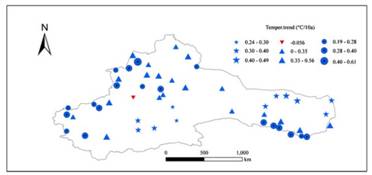Temperature and Precipitation Changes in Different Environments in the Arid Region of Northwest China
2012-10-15
The arid region of northwest China (ARNC), is the vast area in the hinterland of the Eurasian continent. It is located between the western Helan Mountain–Zaocys Ridgeline and the northern Kunlun Mountains. During the past several decades, ARNC experienced considerable environmental change, such as oasis degradation, glacier retreat, water shortage and desertification expansion. In fact, the effects of climate change on natural environment in the arid region cannot be neglected. Many scholars have explored the environment evolution and mechanism in the arid region. Recently, regional climate change and the effect of region underlying surface on the climate change are paid more attention. However, there are limited researches on climate change process and its difference of the mountain, oasis, and desert area in ARNC.
By using data from 51 meteorological stations in the ARNC during the period of 1960 to 2010, this study conducted a comparative analysis for detecting temperature and precipitation changes in the diverse environments. The results showed that, in recent 50 years, temperature has increased at 0.325, 0.339, and 0.360 °C per decade in the mountain, oasis, and the desert areas, respectively. The precipitation has increased at 10.15, 6.29, and 0.87 mm per decade, but in which the increasing trend of precipitation in desert area was not significant. Before the 1990s, the increase in temperature was the fastest in the desert area, up to 0.214 °C per decade, but was the slowest in the mountain area, only 0.103 °C per decade. The temperature rising was faster after the 1990s, 0.606 °C per decade, in the oasis area was fastest, but was the slowest in the desert region with 0.402 °C per decade. The precipitation in each area was stable from 1960 to 1986, but an increase in the oasis and mountain area was larger from 1987 to 2010.
The analysis of this paper showed that the temperature of the oasis landscape was not significantly correlated with the precipitation of any landscape, including that of itself, which might be an indication of the unnatural component in the temperature variation in such landscape. The analysis also indicated that the precipitation of the desert landscape was not significantly correlated with the temperature of any landscape, including that of itself, which reflects the uniqueness of the precipitation process in this type of landscape.
The result has been published on Theoretical and Applied Climatology, 2012. doi: 10.1007/s00704-012-0753-4. The paper can be downloaded from http://www.springerlink.com/content/d86g6v124n883p76/.

The temperature trends at the meteorological stations in the three landscapes for the period 1960–2010 (The red implies decrease, the blue implies increase, and the pentagram, triangle, and circular imply meteorological station in deserts, oases, and mountains, respectively). (Image by XIEG)



